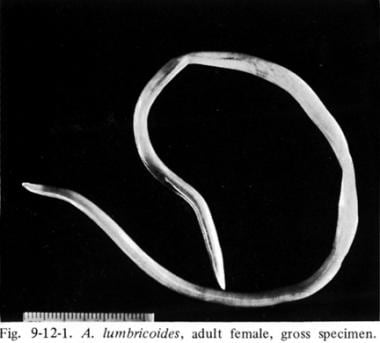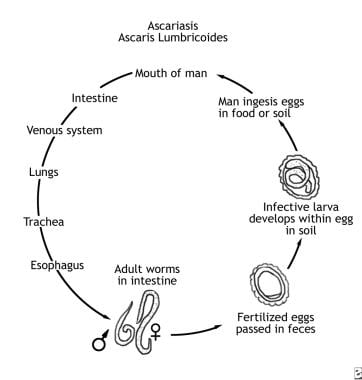Background
Intestinal nematode infections affect one fourth to one third of the world's population. Of these, the intestinal roundworm Ascaris lumbricoides is the most common. While the vast majority of these cases are asymptomatic, infected persons may present with pulmonary or potentially severe gastrointestinal complaints. Ascariasis predominates in areas of poor sanitation and is associated with malnutrition, iron-deficiency anemia, and impairments of growth and cognition.
Ascaris lumbricoides is shown in the image below.
Pathophysiology
A lumbricoides is the largest of the intestinal nematodes affecting humans, measuring 15-35 cm in length in adulthood. Infection begins with the ingestion of embryonated (infective) eggs in feces-contaminated soil or foodstuffs. [1] Once ingested, eggs hatch, usually in the small intestine, releasing small larvae that penetrate the intestinal wall. Larvae migrate to the pulmonary vascular beds and then to the alveoli via the portal veins usually 1-2 weeks after infection, during which time they may cause pulmonary symptoms (eg, cough, wheezing). During the time frame of pulmonary symptoms, eggs are not being shed, and thus diagnosis via stool ovas and parasites is not possible. Eggs are not shed in stool until roughly 40 days after the development of pulmonary symptoms.
After migrating up the respiratory tract and being swallowed, they mature, copulate, and lay eggs in the intestines. Adult worms may live in the gut for 6-24 months, where they can cause partial or complete bowel obstruction in large numbers, or they can migrate into the appendix, hepatobiliary system, or pancreatic ducts and rarely other organs such as kidneys or brain. From egg ingestion to new egg passage takes approximately 9 weeks, with an additional 3 weeks needed for egg molting before they are capable of infecting a new host.
Epidemiology
Frequency
United States
In the United States, approximately 4 million people are believed to be infected. [2] High-risk groups include international travelers, recent immigrants (especially from Latin America and Asia), refugees, and international adoptees. Ascariasis is indigenous to the rural southeast, where cross-infection by pigs with the nematode Ascaris suum is thought to occur. (Children aged 2-10 years are thought to be more heavily infected in this and all other regions.)
International
Worldwide, 1.4 billion people are infected with A lumbricoides, with prevalence among developing countries as low as 4% in Mafia Island, Zanzibar, [3] to as high as 90% in some areas of Indonesia. Local practices (eg, termite mound–eating in Kenya [4] ) may predispose to ascariasis in some populations. Further risk factors include other forms of geophagia and cat/dog ownership. In some regions, Ascaris infection is thought to contribute significantly to the burden of abdominal surgical emergencies.
Mortality/Morbidity
The rate of complications secondary to ascariasis ranges from 11-67%, with intestinal and biliary tract obstruction representing the most common serious sequelae. Although infection with A lumbricoides is often asymptomatic, it is responsible for an estimated 730,000 cases of bowel obstruction annually, 11,000 of which are fatal. [5] In one series of pregnant patients in Bangladesh, biliary ascariasis was responsible for a plurality (28%) of nonobstetric etiologies of acute abdomen. [6]
Owing to similarities in the means of infection, many individuals infected with Ascaris are also co-infected with other intestinal parasites.
Race
No racial predilection is known. A genetic predisposition has been described in a study of families from Nepal. [7]
Sex
Male children are thought to be infected more frequently, owing to a greater propensity to eat soil.
Age
Children, because of their habits (eg, directly or indirectly consuming soil), are more commonly and more heavily infected than adults. Neonates may be infected by transplacental infection. Frequently, families may be infected and reinfected in group fashion due to shared food and water sources as well as hygiene practices.
Prognosis
The prognosis for ascariasis is excellent. However, in higher worm burden infections, serious complications such as obstruction are more common.
Patient Education
Recommend good personal hygiene and food handling techniques: discriminate defecation, hand-washing, cleaning fruits and vegetables, and avoiding soil consumption. Educational programs should also address the use of human feces as fertilizer, a practice that persists in many communities internationally.
-
Adult Ascaris lumbricoides.
-
Life cycle of Ascaris lumbricoides.
-
Ascaris lumbricoides egg.
-
Adult Ascaris lumbricoides in biliary system.
-
The roundworm Ascaris lumbricoides causes ascariasis. Worms can reach 10-30 cm in length. Clinical disease results from effects of pulmonary larval migration, intestinal obstruction, or migration through the biliary tree.
-
Ascaris lumbricoides egg in feces (formalin-ethyl acetate sedimentation method).
-
Endoscopic retrograde cholangiogram shows long, linear, filling defect in common bile duct. Image courtesy of Medscape.com.








